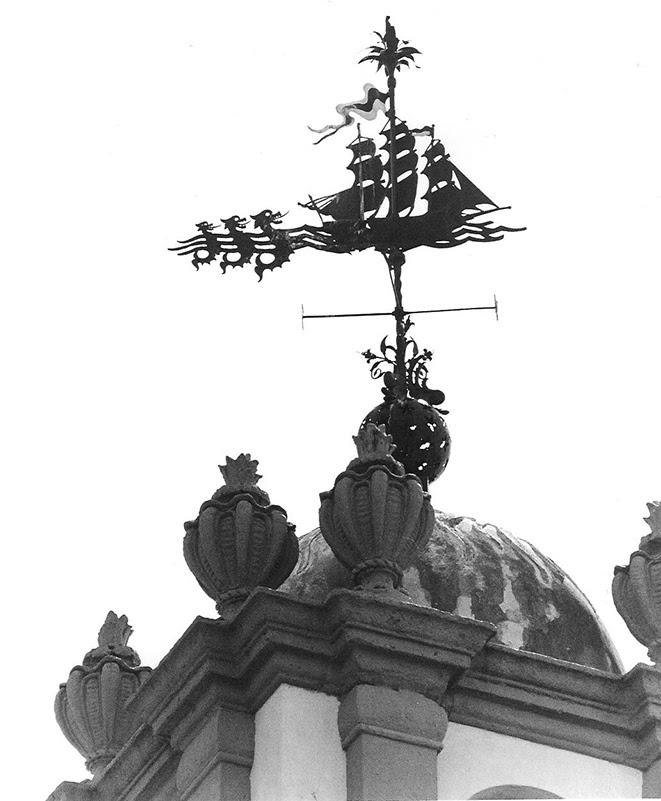Vanderbilt Museum receives grant to restore two Samuel Yellin weathervanes
The Suffolk County Vanderbilt Museum has received a grant of $86,489 from the Robert David Lion Gardiner Foundation that will finance the restoration of two weathervanes that once adorned the Vanderbilt Mansion and the Learning Center.
The mansion weathervane, once atop the Bell Tower, depicts a ship with wind-filled sails plowing through waves, followed by sea serpents, and includes dolphin forms sitting on top of a globe of stars. The sculptural work was created by Samuel Yellin, considered the foremost iron artisan of the twentieth century and known as the “Tiffany of ironwork.”
The large weathervane signifies William K. Vanderbilt II’s love of the seas, his years of circumnavigating the globe, exploring the oceans, and collecting specimens for his marine museum, The Hall of Fishes. The smaller weathervane is simpler — a rotating arrow with scrollwork and embellishments. Deterioration and public safety concerns led the museum to remove both weathervanes 30 years ago.
Restoration will be performed by Spirit Ironworks of Bayport, operated by siblings Rachel and Timothy Miller. For their restoration work at the Henry Street Settlement in New York City, they received the 2020 Stanford White Award for Craftmanship and Artisanship through the Institute of Classical Architecture and Art.
“We are thrilled that the Gardiner Foundation believes in the timeless significance of Samuel Yellin’s magnificent iron artistry — and in the Vanderbilt as stewards of an extensive repository of his unique art. We’re excited that the gifted, award-winning artisans at Spirit Ironworks will be restoring our Yellin collection,” said Vanderbilt Museum Executive Director Elizabeth Wayland-Morgan.
“Willliam Vanderbilt’s Eagle’s Nest is one of the few remaining North Shore estates open to the public. There were more than 1,200 built in the late nineteenth and early twentieth centuries. The Vanderbilt is one of the jewels of our Suffolk County parks system. These weathervanes, initially utilitarian objects, showcase the mastery of Yellin’s artistic interpretation and craftsmanship. Their restoration and re-installation will offer the visitor a new insight into how their Long Island Gold Coast neighbors curated and celebrated even the smallest details of their homes,” said Kathryn M. Curran, executive director of the Robert David Lion Gardiner Foundation.
“This commitment to preserve the two weathervanes produced by Samuel Yellin for William K. Vanderbilt II represents an incredible gift from the Robert D.L. Gardiner Foundation to Long Island’s rich heritage in the decorative arts. As the foremost artisan in wrought iron, Samuel Yellin fabricated architectural and ornamental fixtures for some of the more culturally significant constructions of the early twentieth century,” said Paul Rubery, director of curatorial affairs.
“In the past year, the weathervane — a unique alchemy of sculpture, scientific instrument, and public artwork — has specifically enjoyed renewed appreciation among art lovers and historians who seek to understand the full breadth of American craft. We look forward to the day when these historically significant works can greet our visitors from their proper positions on the Learning Center and Bell Tower rooftops,” he added.
“Master blacksmith Samuel Yellin has an incredible body of work at the Vanderbilt Museum. By restoring two of his weathervanes, we gain respect for the elevated level of skill and design he used to create these works of art. Starting with a three-masted ship followed by sea serpents atop a star-filled globe, Yellin transformed a simple weathervane into a sculpture that honored his patron’s love of the sea, adventure, and exploration,” said Rachel Miller of Spirit Ironworks.
“As fellow artist-blacksmiths here at Spirit Ironworks, we are honored to preserve a small part of his legacy by staying faithful to many of his means and methods used in these lovingly crafted weathervanes.”







